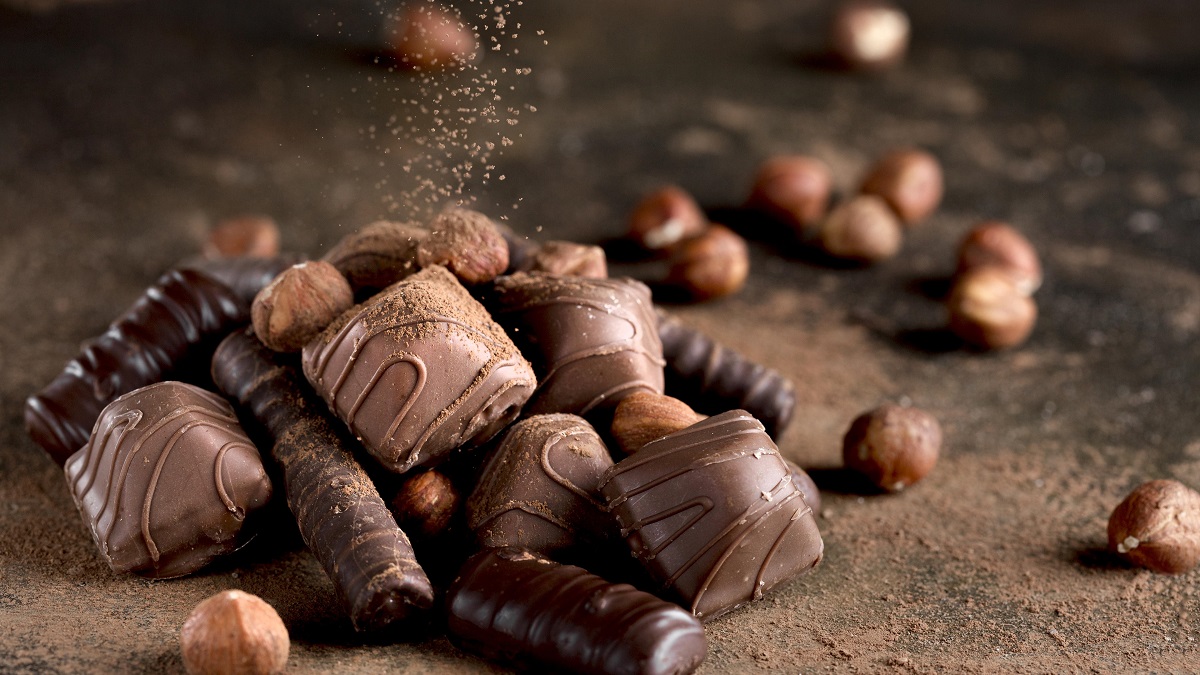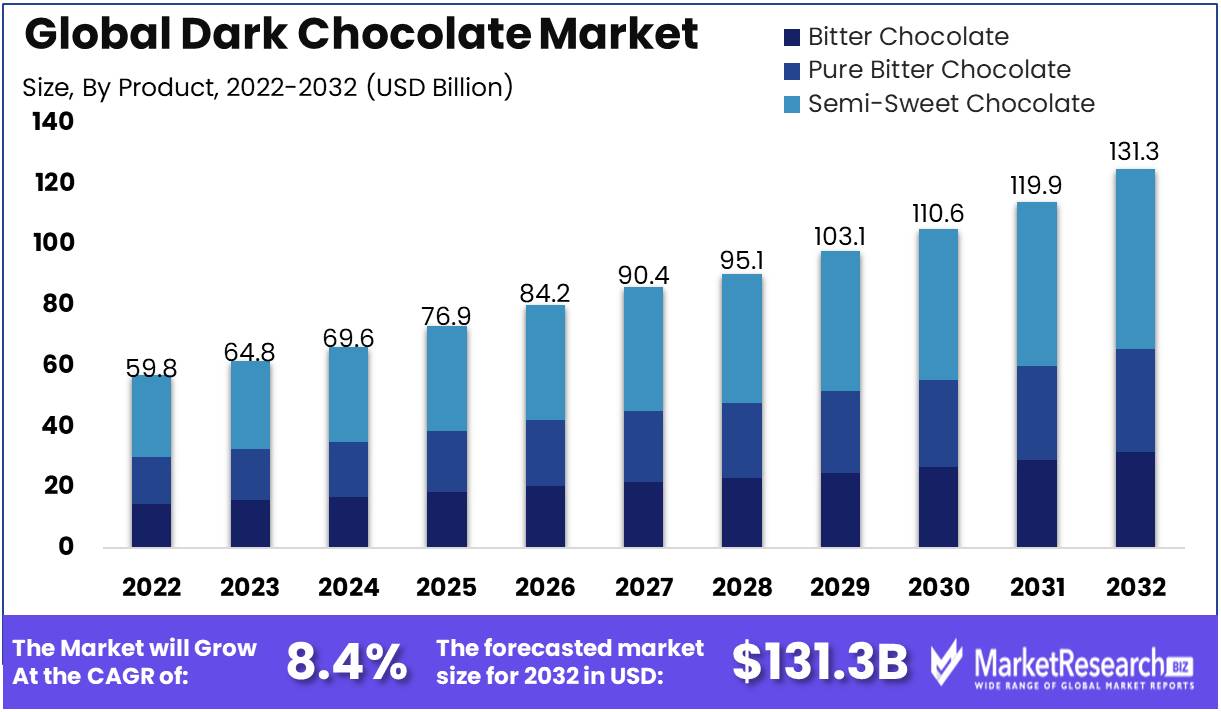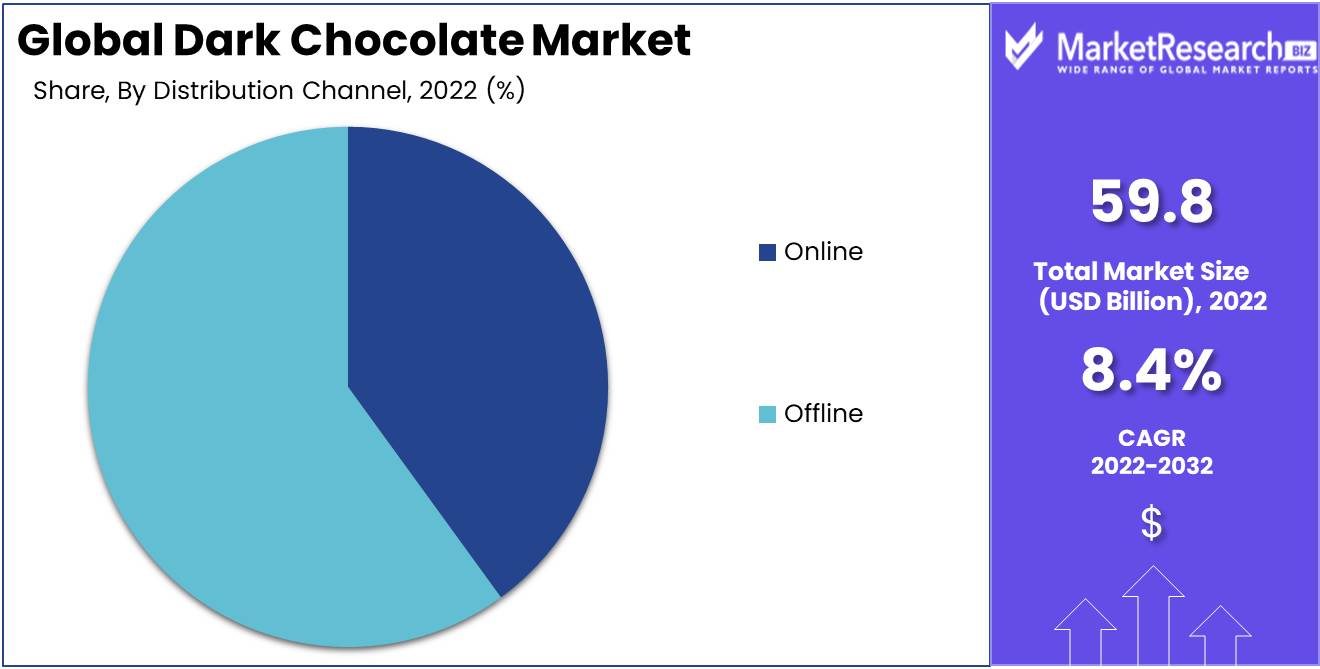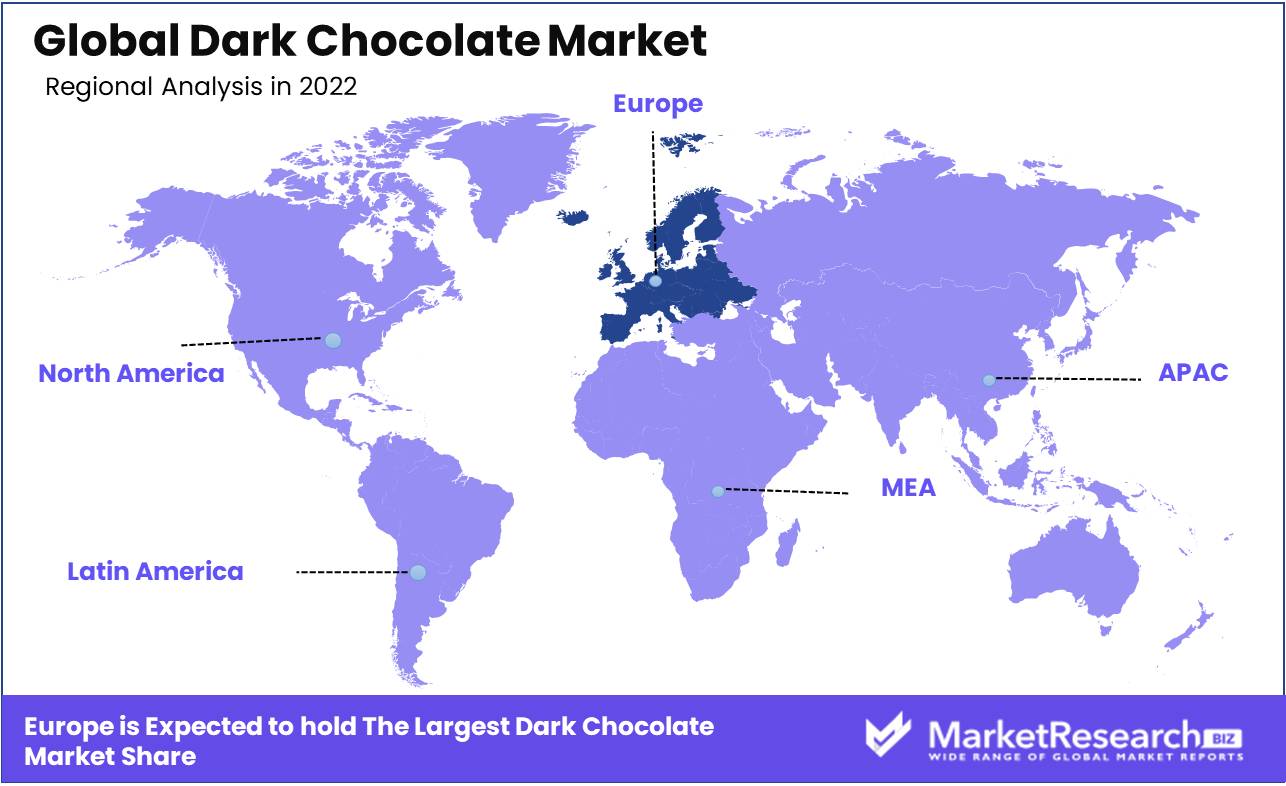
Dark Chocolate Market By Product (Pure Bitter Chocolate, Semi-Sweet Chocolate, Other), By Distribution Channel (Online, Offline, Other), By Region And Companies - Industry Segment Outlook, Market Assessment, Competition Scenario, Trends, And Forecast 2023-2032
-
38234
-
June 2023
-
179
-
-
This report was compiled by Shreyas Rokade Shreyas Rokade is a seasoned Research Analyst with CMFE, bringing extensive expertise in market research and consulting, with a strong background in Chemical Engineering. Correspondence Team Lead-CMFE Linkedin | Detailed Market research Methodology Our methodology involves a mix of primary research, including interviews with leading mental health experts, and secondary research from reputable medical journals and databases. View Detailed Methodology Page
-
Quick Navigation
Report Overview
The Global Dark Chocolate Market size is expected to be worth around USD 131.4 Bn by 2032 from USD 59.8 Bn in 2022, growing at a CAGR of 8.4% during the forecast period from 2023 to 2032.
The global dark chocolate market report's in-depth analysis reveals fascinating market trends. This comprehensive research covers the market's size, growth rate, and major players. It also highlights the many causes driving the market's growth and provides a broad view of dark chocolate's many uses in the food industry.

Dark chocolate, a delicious cocoa-laden candy, has a harsh taste due to its higher cocoa solids and lack of milk. In baking and confectionary, this beautiful delicacy is cherished for its distinctive qualities. While dark chocolate has been around for generations, its newfound popularity is due to its supposed health-conscious appeal.
The dark chocolate market is always evolving, creating new flavors and blending nicely with a wide range of treats. This business pushes limits, delighting taste sensations with dark chocolate energy bars and granola crunch. Manufacturers have passionately used high-grade cocoa beans to create a dazzling symphony of quality that delights chocolate connoisseurs worldwide. The business has also made strides toward ethical and environmental methods, giving fair trade solutions that go beyond mere delectation and foster a sense of responsibility for the globe.
Dark chocolate's popularity has spurred massive investments. Ice cream now blends with dark chocolate, and snack bars offer a world of flavor. These forays into unexplored areas revitalize the market and provide a promising future.
The global dark chocolate market will continue to grow, driven by consumer demand for healthier, more sustainable food. Premium confectionary and pastry products will attract consumers in developed and developing countries.
The food and beverage business dominates dark chocolate investment, embracing its velvety appeal. Dark chocolate is an essential component of inventive gastronomy since it is a high-value ingredient that gives life to innumerable tasty creations. Dark chocolate has drawn the pharmaceutical industry's attention.
The global dark chocolate market is driven by a variety of reasons, including rising demand for healthier, sustainable products. As awareness of the health benefits of dark chocolate grows, its popularity as a snack food grows, fueling the market's rapid growth.
With the dark chocolate market's rapid growth, ethical and sustainable standards are demanded. Manufacturers strongly support the cause by using fair trade and organic ingredients. This unprecedented dedication to transparency, explainability, and responsibility gives the business fresh life and propels dark chocolate into a domain where its attractiveness remains unmatched.
Driving Factors
Dark Chocolate Market Grows on Healthy Indulgence
Global dark chocolate market growth is substantial due to numerous causes. Consumer demand for decadent and healthy chocolates is one such factor. Consumers are growing more health-conscious and seeking products that offer enjoyment without sacrificing health advantages. Dark chocolate, in particular, is good for your heart and brain.
Dark Chocolate Gains Popularity
Premium and gourmet dark chocolate are also available. High-quality, handmade chocolates that offer unique tastes command a premium. This has led to an increase in demand for premium and gourmet dark chocolates, which has positively benefited the market.
Dark Chocolate's Versatility Grows Market
Dark chocolate's culinary uses in confectionery and baking have also boosted market growth. Dark chocolate is versatile in desserts and baked items. This has led to increased demand from professional and home bakers, which is expected to drive growth in the dark chocolate industry.
Healthier Dark Chocolate Labels Increase Transparency
No substantial regulatory changes are expected to impact the dark chocolate sector. Transparent labeling and ingredient sourcing may become more important as demand for healthy options rises.
Newcomers and Innovation Disrupt Dark Chocolate Market
Potential disruptors could impact the dark chocolate market with new, novel tastes or ingredients, or new, disruptive firms that can offer distinct value propositions to consumers.
Sustainable E-commerce Drives Dark Chocolate Market Trends
Finally, consumer trends may impact the dark chocolate market. E-commerce and online buying have made dark chocolate products from around the world more accessible to consumers. The demand for organic and ecological products is expanding, which could boost the growth of ethical dark chocolate manufacturers.
Restraining Factors
The Expanding Dark Chocolate Market is Constrained
The global market for dark chocolate has grown consistently over the years, as its health benefits and rich flavor have increased its demand. Aside from its numerous advantages, the market's growth is being restrained by a number of factors. Some of these factors include fluctuating cocoa prices, competition from other chocolate varieties, potential flavor consistency challenges, and sustainable cocoa sourcing.
Difficulties Influencing the Dark Chocolate Market
As cocoa is an essential component in the manufacturing of dark chocolate, its price has a substantial impact on the market. In recent years, cocoa prices have increased significantly due to factors such as high demand and limited supply. This has increased the cost of producing and distributing dark chocolate products, negatively affecting the market.
Confronting Dark Chocolate Challenges
To combat this, chocolate manufacturers and cocoa farmers are working to increase cocoa bean productivity and quality. To assure a constant supply of high-quality cocoa at an affordable price, they are also developing new cocoa varieties that are more resistant to climate change and disease.
Improving Dark Chocolate Appearance
The market for dark chocolate is hampered by severe competition from other chocolate varieties. Milk and white chocolate varieties, for example, are widely available and preferred by some consumers. These chocolate varieties have significantly hindered the expansion of the dark chocolate market.
Consistency of Flavor in Dark Chocolate
To combat this, manufacturers of dark chocolate are developing new and distinctive flavors while emphasizing the health benefits of dark chocolate. They are utilizing new marketing strategies to inform consumers about the numerous health advantages of dark chocolate, including its high cocoa content, which is rich in antioxidants and essential minerals.
Assuring the Quality of Dark Chocolate
Dark chocolate has a distinctive flavor that is determined by a number of factors, including the type of cocoa, the refining method, and the storage conditions. This can make it difficult to maintain flavor consistency across various batches, which can negatively affect the manufacturer's reputation and the market as a whole.
Sustainability of Dark Chocolate Sourcing
Manufacturers are investing in enhanced testing and quality control procedures, such as sensory testing and flavor profiling, to combat this issue. In addition, they are working on developing new processing techniques that will help maintain the intended flavor and texture in their dark chocolate products.
Satisfying the Need for Ethical Cocoa
The difficulty of obtaining sustainable cocoa is another factor restraining the dark chocolate market. Cocoa cultivation is frequently associated with deforestation, child labor, and other unethical practices that negatively affect the environment and society. This has increased the demand for sustainable cocoa, which is produced using eco-friendly methods and pays producers fairly.
Product Analysis
The Dark Chocolate Market is one of the most vibrant. The market is seeing a rise in demand for dark chocolate over milk chocolate due to its health benefits. The market has changed products, distribution routes, and prices according to changing consumer behavior and tastes. Due to its health benefits, flavor profile, and versatility, demand for semi-sweet chocolate has increased in recent years.
The semi-sweet chocolate segment now dominates the global dark chocolate market, leading to growth potential. The segment is known for its delicious flavor experience. Due to health-conscious consumers, a preference for dark chocolate over milk chocolate, and technological advances that allow for creative semi-sweet chocolate formulations, the semi-sweet chocolate segment is predicted to develop the fastest.
Emerging economies have fueled the growth of the semi-sweet chocolate segment. Demand for luxury chocolate products has expanded in emerging nations due to the rise in disposable incomes, rapid urbanization, and growing consumer knowledge of health advantages. The middle class in these markets prefers high-end products, thus global manufacturers want to tap into this market by introducing cutting-edge products.
The consumer demand for semi-sweet chocolate has been developing as a result of changing lifestyles and healthier eating choices. The chocolate consumer segment includes adults, children, and millennials who are health-conscious. Semi-sweet chocolate's versatility and adaptability allow it to be used in a variety of food applications, such as baking, confectionery, and meal replacements.
Due to factors such as rising health awareness and demand for premium-quality organic chocolate, semi-sweet chocolate is anticipated to register the quickest growth rate. The health benefits of semi-sweet chocolate have been well-studied, leading to its greater adoption in the food industry. The product caters to a broad consumer segment, including health-conscious youngsters and adults who seek organic and ethical products.
Distribution Channel Analysis
The global dark chocolate product market's performance depends heavily on the distribution of chocolate products. Manufacturers have utilized several distribution channels to reach consumers worldwide. The distribution channel's offline segment dominates the market.
Due to factors like the availability of a wide selection of products, personalized customer care, and the ability to try the product before buying it, the offline distribution channel for dark chocolate bars dominates the market. The offline segment allows for impulse purchases, which enhances the shopping experience and consumer involvement.
Economic growth in emerging economies is promoting offline distribution channel segment adoption. There is a rise in demand for offline retail establishments due to the expansion of the middle-class population in emerging nations and the rise in disposable incomes. The personalized and engaging shopping experience provided by offline retailers enhances the customer's perception of the product.
Despite the availability of online platforms, the offline consumer segment of the distribution channel is rising. Because they give a personalized and engaging experience that enhances the buying experience, consumers choose offline channels. The offline segment also lets customers personally test the product, increasing consumer confidence in the product.
The offline segment of the distribution channel is anticipated to develop at the highest rate due to factors such as personalized service, impulse buying, and the ability to test the product before purchasing it. There is a rise in demand for offline retail establishments due to the expansion of the middle-class population in emerging nations and the rise in disposable income. To leverage the increased demand for offline retail locations, manufacturers must expand their offline presence due to these factors.

Key Market Segments
By Type
- Organic
- Convectional
By Product
- Bitter Chocolate
- Pure Bitter Chocolate
- Semi-Sweet Chocolate
By Application
- Food and Beverages
- Cosmetics
- Pharmaceuticals
- Other Applications
By Distribution Channel
- Online
- Offline
Growth Opportunity
Innovative Flavors Drive Market Growth for Dark Chocolate
Product innovation with novel flavors and inclusions is one of the primary factors propelling the growth of the dark chocolate market. Manufacturers of dark chocolate are experimenting with new flavors, including salted caramel, mint, and raspberry. Nuts, fruits, and seasonings are being incorporated into chocolate to improve its flavor and texture. Additionally, companies are introducing vegan, organic, and sugar-free dark chocolate to meet evolving consumer demands.
In Emerging Markets, Dark Chocolate Thriving.
In emerging markets such as China, India, and Brazil, the consumption of dark chocolate is increasing. In these regions, the demand for dark chocolate is fueled by a high discretionary income, rising health consciousness, and shifting consumer tastes. Leading manufacturers such as Mondelez International, Inc., Nestle S.A., and Lindt & Sprungli AG are expanding their operations in these markets to capitalize on their growth potential.
Industry Adopts Ethical Dark Chocolate Sourcing
There is pressure on the dark chocolate industry to ensure that cocoa is sourced and produced ethically, without harming the environment or violating human rights. Companies are increasingly employing sustainable and ethical practices, such as fair trade certification, to promote responsible sourcing and ensure supply chain transparency.
Dark Chocolate Sales Are Influenced by Health Benefits
Marketing campaigns emphasizing the health advantages of dark chocolate have also contributed to market growth. Dark chocolate contains a lot of antioxidants, which help prevent heart disease and lower blood pressure. Manufacturers are capitalizing on this health benefit to promote dark chocolate as a nutritious snack to health-conscious consumers.
Latest Trends
Global Dark Chocolate Market Changes
Consumer preferences and trends in dark chocolate are changing globally. The worldwide dark chocolate industry is shaped by important market trends that influence consumer behavior. These trends include high-cocoa-content dark chocolate, functional dark chocolate containing antioxidants and superfoods, single-origin and artisanal dark chocolates, and dark chocolate desserts and beverages.
Healthier Option High-Cocoa Dark Chocolate
Chocolate choices are reflecting consumers' health awareness. Dark chocolate with high cocoa content is becoming more popular as a healthy alternative to milk chocolate. The high cocoa content increases flavonoid antioxidants, which are good for the heart. Cacao solids' reduced sugar content is healthier. Due to its therapeutic benefits, the demand for high cocoa-content dark chocolate is predicted to rise. People are seeking chocolate with high cocoa content and low sugar as they become more health conscious.
Dynamic Dark Chocolate
Dark chocolate with antioxidants, superfoods, and probiotics is gaining popularity. As these functional compounds have health advantages, the demand for functional dark chocolate has increased. Probiotic dark chocolate boosts immunity and intestinal health. Antioxidant-rich dark chocolate reduces inflammation and promotes skin health. Goji berry, spirulina, and matcha-infused dark chocolate are also popular with health nuts.
Artisanal Dark Chocolates Grow
Single-origin and artisanal dark chocolates are a new chocolate industry category. Consumers are increasingly pickier about chocolate sources and flavors. For instance, single-origin dark chocolate has a distinct taste. Traditional methods increase the cocoa flavor and aroma in artisanal dark chocolates. Gourmet foodies love these chocolates, thus this particular market has a dedicated following and growing demand.
Dark Chocolate Treats
Dark chocolate foods and beverages are growing more popular as chocolate moves beyond sweets. Dark chocolate-based sweets such as cakes, brownies, truffles, and mousse are gaining popularity among dessert enthusiasts who wish to satisfy their appetites guilt-free, knowing that the high content of cocoa gives health benefits. Dark chocolate beverages including hot chocolate, smoothies, and cocktails are also popular. Adding pure dark chocolate to their favorite drinks fulfills their taste senses.
Regional Analysis
Europe dominates the dark chocolate market. Dark chocolate has been loved throughout for millennia. Its rich flavor and health benefits make it desirable. Europe dominates the dark chocolate market. Europe has established itself as a leader in dark chocolate quality. This essay will explain why Europe dominates the dark chocolate market and what makes them unique from the rest of the globe.
Mayan civilization in Central America invented dark chocolate about 3,000 years ago. Mayans considered chocolate a spiritual drink. It was thought to boost energy and stave off hunger. Dark chocolate, however, didn't exist until the 19th century.
Europe invented solid chocolate and cocoa processing. Roasted, winnowed, ground and refined cocoa beans make chocolate. Europeans refined chocolate's cocoa butter and smoothed it with the conching process. Europe has mastered the technique of making high-quality dark chocolate.
Europe dominates the dark chocolate market due to high-quality raw resources. European cocoa is known for its quality. European dark chocolate uses West African, Caribbean, and South American beans. These climates produce high-quality cocoa beans with diverse flavors.
Europeans have improved the chocolate-making process over the ages. Europe's chocolate-making methods are generations old. European chocolate shows their understanding of the process. Europe produces high-quality chocolate due to its chocolate-making expertise.
Tradition is evident in European chocolate making. Europe has utilized the same chocolate-making methods for generations. Tradition ensures that European chocolate is high-quality and flavorful.
Europeans innovate chocolate making. They strive to improve the process and add new flavors. This innovation has created world-first chocolate flavors. This innovation keeps Europe a dark chocolate leader.

Key Regions and Countries
North America
- US
- Canada
- Mexico
Western Europe
- Germany
- France
- The UK
- Spain
- Italy
- Portugal
- Ireland
- Austria
- Switzerland
- Benelux
- Nordic
- Rest of Western Europe
Eastern Europe
- Russia
- Poland
- The Czech Republic
- Greece
- Rest of Eastern Europe
APAC
- China
- Japan
- South Korea
- India
- Australia & New Zealand
- Indonesia
- Malaysia
- Philippines
- Singapore
- Thailand
- Vietnam
- Rest of APAC
Latin America
- Brazil
- Colombia
- Chile
- Argentina
- Costa Rica
- Rest of Latin America
Middle East & Africa
- Algeria
- Egypt
- Israel
- Kuwait
- Nigeria
- Saudi Arabia
- South Africa
- Turkey
- United Arab Emirates
- Rest of MEA
Key Players Analysis
Due to its numerous health benefits and rising consumer demand for premium chocolate products, the global market for dark chocolate has experienced rapid expansion. Nestle SA, Mondelz International, Mars, Inc., Lindt & Sprüngli AG, Ferrero SpA, Hershey's Co., Ghirardelli Chocolate Co., Valrhona, Meiji Holdings Co. Ltd., and Barry Callebaut are some of the key participants in the global dark chocolate market.
Nestle is one of the world's largest multinational food and beverage corporations, offering a variety of chocolate products under brands such as KitKat, Aero, and Smarties. The company has invested significantly in product innovation and R&D to provide its customers with high-quality chocolate products.
Mondelz International, formerly known as Kraft Foods, is one of the leading confectionery companies offering Cadbury-branded chocolate products. The company has been focusing on sustainable cocoa bean sourcing to ensure that its products are environmentally and socially responsible.
Lindt & Sprüngli AG is a Swiss chocolatier that offers premium chocolate products under a variety of brands, including Lindt, Ghirardelli, and Russell Stover. In order to cater to the increasing consumer demand for premium chocolate products, the company has been focusing on product innovation and retail footprint expansion.
Ferrero SpA is an Italian chocolatier that offers chocolate products under a variety of brands, including Ferrero Rocher, Kinder, and Nutella. In order to cater to the evolving preferences of consumers, the company has been focusing on product innovation and the expansion of its product portfolio.
Overall, the global market for dark chocolate is extremely competitive, with key players investing significantly in R&D, product innovation, and sustainability to ensure that their products remain relevant and competitive.
Top Key Players in Dark Chocolate Market
- Barry Callebaut
- Chocoladefabriken Lindt & Sprüngli AG
- Mondelēz International, Inc.
- Nestlé
- The Hershey Company
- Ferrero Group
- Mars, Incorporated
- The Australian Carob Co.
- Meiji Holdings Co., Ltd.
- Other Key Players
Recent Development
- In 2023, There has been a growing emphasis on the potential health benefits of dark chocolate in recent years.
- In 2022, The market for dark chocolate will see an increase in demand for plant-based and vegan products. In response, chocolate manufacturers have developed alternatives to traditional dairy-based chocolates that are derived from plants.
- In 2021, There has been a surge in the introduction of novel dark chocolate varieties in recent years.
- In 2020, The dark chocolate industry emphasized sustainable procurement and fair trade practices more.
- In 2019, In recent years, the prevalence of craft and artisanal dark chocolate has increased significantly.
Report Scope:
Report Features Description Market Value (2022) USD 59.8 Bn Forecast Revenue (2032) USD 131.3 Bn CAGR (2023-2032) 8.4% Base Year for Estimation 2022 Historic Period 2016-2022 Forecast Period 2023-2032 Report Coverage Revenue Forecast, Market Dynamics, COVID-19 Impact, Competitive Landscape, Recent Developments Segments Covered By Type (Organic, Convectional), By Product (Bitter Chocolate, Pure Bitter Chocolate, Semi-Sweet Chocolate), By Application (Food and Beverages, Cosmetics, Pharmaceuticals, Other Applications), By Distribution Channel (Online, Offline) Regional Analysis North America – The US, Canada, & Mexico; Western Europe – Germany, France, The UK, Spain, Italy, Portugal, Ireland, Austria, Switzerland, Benelux, Nordic, & Rest of Western Europe; Eastern Europe – Russia, Poland, The Czech Republic, Greece, & Rest of Eastern Europe; APAC – China, Japan, South Korea, India, Australia & New Zealand, Indonesia, Malaysia, Philippines, Singapore, Thailand, Vietnam, & Rest of APAC; Latin America – Brazil, Colombia, Chile, Argentina, Costa Rica, & Rest of Latin America; Middle East & Africa – Algeria, Egypt, Israel, Kuwait, Nigeria, Saudi Arabia, South Africa, Turkey, United Arab Emirates, & Rest of MEA Competitive Landscape Barry Callebaut, Chocoladefabriken Lindt & Sprüngli AG, Mondelēz International, Inc., Nestlé, The Hershey Company, Ferrero Group, Mars, Incorporated, The Australian Carob Co., Meiji Holdings Co., Ltd., Other Key Players Customization Scope Customization for segments, region/country-level will be provided. Moreover, additional customization can be done based on the requirements. Purchase Options We have three licenses to opt for: Single User License, Multi-User License (Up to 5 Users), Corporate Use License (Unlimited User and Printable PDF) -
-
- Barry Callebaut
- Chocoladefabriken Lindt & Sprüngli AG
- Mondelēz International, Inc.
- Nestlé
- The Hershey Company
- Ferrero Group
- Mars, Incorporated
- The Australian Carob Co.
- Meiji Holdings Co., Ltd.
- Other Key Players




